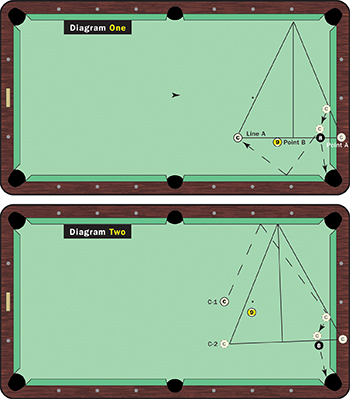Looking deeper into the mirror image kicking system.
Last issue, I described a quick and easy system for measuring angles for kick shots ó the mirror image system. Generally speaking, the mirror image calls for you to find the desired contact point on the object ball (for one-rail kicks) or second rail (for two rail kicks), and follow a line from that point through the rail that you plan to hit first. Your aiming point is roughly twice the distance of the contact point to the edge of the rail.
Of course, there are adjustments that will need to be made in some circumstances, and I will explain those later. First, letís look at another example of a two-rail kick. The shot in Diagram One comes up quite often, but most players are still simply guessing where to strike the first rail.
In truth, you should make this shot a high percentage of the time. Using the mirror image approach will greatly improve your chances.
Again, begin by determining the ideal contact point on the 8 ball. Draw an imaginary line to the rail, then double that distance (Point A). Now, find the halfway point (Point B) between the cue ball and that point on the rail. The line to the long rail (Line A) will give you the ideal spot for the cue ball to hit that first rail.
Once you have determined those points, it is all about execution and trust. Use high cue ball with a trace of running English, with enough speed to make the shot and get the cue ball to return to its original spot. This speed will give you the best chance to leave your opponent safe if you donít make the shot.
So, what happens if the cue ball is in a position that is not in line with the ideal contact point?
As you can see in Diagram Two, the cue ball (C-1) being closer to the center of the table makes gauging the shot a little more difficult. For starters, find that contact point on the 8 ball again. Follow a line from the cue ball to a point that is in line with the 8 ball (C-2). Now you can do the same measurements that you did for Diagram One. Once you have established the line of aim from C-2, imagine a parallel line from C-1. That line will give you the proper path to the contact point on the second rail.
Since you have to draw an imaginary line from the actual cue ball position (C-1), I find it helpful to pick out a spot in the distance that is along that parallel line of aim. It could be a chair, a picture on the wall, etc. This is important because this is where a lot of players get stuck if the cue ball isnít perfectly lined up with the 8, as in Diagram One.
Try a few shots like these and you will quickly see impressive results. After a while, finding the proper lines of aim will become quick and easy.






